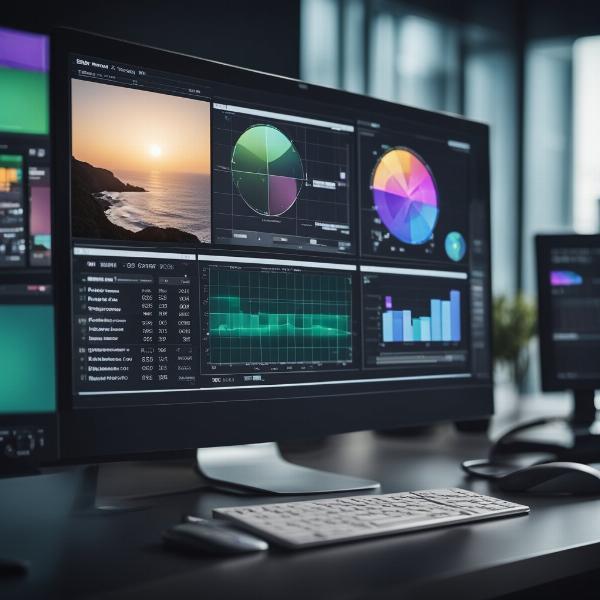Mastering the Art of Color Correction in Video Editing: A Guide for Storytellers

Strong 8k brings an ultra-HD IPTV experience to your living room and your pocket.
Video editing transcends simple image stitching. It's an art form where stories unfold through meticulously crafted visuals. Colour correction sits at the heart of this art, wielding the power to set the mood, establish a visual identity, and subtly guide the viewer's gaze. Regardless of your experience level, mastering colour correction empowers you to elevate your videos from ordinary to captivating.
Demystifying the Fundamentals: Color Correction vs. Color Grading
Before diving into the technicalities, it's crucial to differentiate between colour correction and colour grading. While often used interchangeably, they fulfil distinct purposes:
Color Correction: This is the technical bedrock. Its objective is to rectify issues with the original footage, ensuring a consistent and accurate colour representation. This might involve:
Exposure and Contrast: Adjust brightness and contrast to guarantee proper visibility and details within the frame. Imagine a foggy landscape; colour correction brings clarity and reveals hidden information.
White Balance: neutralizing unwanted colour casts caused by varying lighting conditions. This ensures whites appear white, eliminating the greenish tinge from fluorescent lights or the warm orange cast from incandescent bulbs.
Saturation and Vibrance: fine-tuning the intensity and richness of colours. You can enhance the natural vibrancy of a sunset or create a more muted look for a historical documentary.
Colour Grading: This is the realm of creative colour manipulation. It transcends technical accuracy, allowing you to establish a specific visual style or evoke a particular mood for your video. Colour grading might involve:
Colour Palettes: Choosing a dominant colour scheme that evokes a specific emotion or reinforces the narrative. For example, a film set in a dystopian future might utilize a cold, blue-green palette, while a romantic comedy might lean towards a warm, pastel palette.
Creative Looks: Applying stylistic effects like film emulations, vintage tones, or high-contrast looks to enhance visual storytelling. Imagine replicating classic Westerns' grainy, washed-out aesthetic or a superhero film's vibrant, saturated hues.
To create a visually cohesive and powerful experience, think of colour correction as the building blocks and colour grading as the finishing touches.
Building Your Arsenal: Essential Color Correction Tools
Most video editing software offers a comprehensive colour correction toolkit. Here are some key features you'll encounter:
Three-way colour wheels: You may adjust the hue, saturation, and brightness of particular colour ranges in your image using three-way colour wheels. Consider reducing the intensity of the green tones in a woodland picture and isolating them to produce a lush, lively feeling.
Curves: These powerful tools let you create custom curves to manipulate brightness and contrast levels across different image parts. Imagine selectively brightening specific areas like a character's face or darkening the background to create a sense of depth.
Scopes: Tools like vectorscopes and histograms visually represent colour distribution within the frame. These act like technical compasses, helping you achieve precise colour balance. Imagine a vectorscope displaying a colour cast on the red spectrum. You can use this information to neutralize the red cast and achieve a more natural-looking image.
Colour Grading Panels: Advanced software offers dedicated colour grading panels with comprehensive tools. These panels provide a unified workspace for advanced colour manipulation and creative effects. Imagine having a dedicated workspace with all the tools at your fingertips, allowing for seamless and precise colour grading.
Understanding the functionalities of these tools and how they interact allows you to gain precise control over the colour correction process.
Mastering the Craft: Essential Color Correction Techniques
Let's now explore some fundamental colour correction methods that will improve your abilities as a video editor:
Maintaining Consistency Across Shots: Consistency is key! Ensure consistent colour across all clips in your video, especially when dealing with footage shot in different environments or lighting conditions. Use reference tools like waveform monitors and vectorscopes to compare clips and make subtle adjustments to maintain a seamless visual flow. Imagine a montage of interview clips shot in various locations. Colour correction ensures the interviewee's skin tones and overall colour balance remain consistent throughout the montage.
Perfecting Skin Tones: Natural skin tones are crucial for maintaining realism and viewer engagement. Use dedicated skin tone correction tools to neutralize unwanted colour casts and achieve a healthy, natural look. Imagine correcting a greenish skin tone caused by fluorescent lighting in an interview setting. This ensures the interviewee appears natural and avoids distracting viewers.
Revealing Details in Highlights and Shadows: Sometimes, details get lost in overly bright or dark areas (highlights and shadows). Adjust the levels in these areas to reveal important details and ensure proper visibility without losing information. Imagine a scene with a character standing in a doorway. Colour correction can brighten the doorway to reveal the character's details without blowing out the highlights in the background.
Note: IndiBlogHub features both user-submitted and editorial content. We do not verify third-party contributions. Read our Disclaimer and Privacy Policyfor details.


